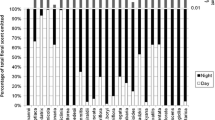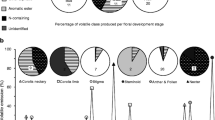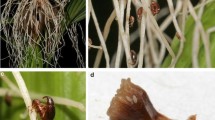Abstract
The floral scent composition of 32 European and two Asian Salix L. species (Salicaceae) was analyzed. Intra- and interspecific variation was compared for a subset of 8 species. All Salix species are dioecious and floral scent was collected from both male and female individuals by using a dynamic headspace MicroSPE method, and analyzed by GC-MS. A total of 48 compounds were detected, most of them being isoprenoids and benzenoids. Commonly occurring compounds included trans-β-ocimene, cis-β-ocimene, benzaldehyde, d-limonene, α-pinene, cis-3-hexenyl aceatate, linalool, 1,4-dimethoxybenzene, and β-pinene. Two compounds, 1,4-dimethoxybenzene and trans-β-ocimene, were responsible for most of the interspecific variation. In a subset of eight extensively sampled species, six had a characteristic floral scent composition; half of the pairwise species comparisons confirmed significant differences. In three of these eight species, intraspecific variability could be explained by sex differences. Variation in Salix floral scent may provide specific signals that guide pollinators and thus contribute to the reproductive isolation of compatible and cooccurring species.



Similar content being viewed by others
References
Adams, R. P. 1995. Identification of Essential Oil Components by Gas Chromatography/Mass Spectrometry. Allured Publishing Corporation, Carol Stream, Illinois USA.
Adler, L. S. 2000. The ecological significance of toxic nectar. Oikos 91:409–420.
Andersen, R. A., Hamiltonkemp, T. R., Loughrin, J. H., Hughes, C. G., Hildebrand, D. F., and Sutton, T. G. 1988. Green leaf headspace volatiles from Nicotiana tabacum lines of different trichome morphology. J. Agric. Food Chem. 36:295–299.
Andersson, S. 2003. Antennal responses to floral scents in the butterflies Inachis io, Aglais urticae (Nymphalidae), and Gonepteryx rhamni (Pieridae). Chemoecology 13:13–20.
Andersson, S., Nilsson, L. A., Groth, I., and Bergström, G. 2002. Floral scents in butterfly-pollinated plants: possible convergence in chemical composition. Bot. J. Linn. Soc. 140:129–153.
Argus, G. W. 1974. Experimental study of hybridization and pollination in Salix (willow). Can. J. Bot. (Rev. Can. Bot.) 52:1613–1619.
Argus, G. W. 1997. Infrageneric Classification of Salix (Salicaceae) in the New World. Systematic Botany Monographs. American Society of Plant Taxonomists, USA.
Ashman, T. L., Bradburn, M., Cole, D. H., Blaney, B. H., and Raguso, R. A. 2005. The scent of a male: the role of floral volatiles in pollination of a gender dimorphic plant. Ecology 86:2099–2105.
Baker, H. G. 1976. “Mistake” pollination as a reproductive system with special reference to the Caricaceae. In J. Burley and B. T. Styles (eds.). Tropical trees: variation, breeding system and conservation (pp. 161–169). Academic Press, London, UK.
Bischoff, I., Feltgen, K., and Breckner, D. 2003. Foraging strategy and pollen preferences of Andrena vaga (Panzer) and Colletes cunicularius (L.) (Hymenoptera:Apidae). J. Hymenopt. Res. 12:220–237.
Boesch, D. F. 1977. Application of Numerical Classification in Ecological Investigations of Water Pollution. Special Scientific Report, Institute of Marine Science, Virginia, Virginia.
Borg, I. and Lingoes, J. 1987. Multidimensional Similarity Structure Analysis. Springer Verlag, Berlin.
Chittka, L. and Thompson, J. D. 2001. Cognitive Ecology of Pollination—Animal Behavior and Floral Evolution. Cambridge University Press, Cambridge.
Clarke, K. R. 1993. Non-parametric multivariate analyses of changes in community structure. Aust. J. Bot. 18:117–143.
Clarke, K. R. and Warwick, R. M. 2001. A further biodiversity index applicable to species lists: variation in taxonomic distinctness. Mar. Ecol. Prog. Ser. 216:265–278.
Cunningham, J. P., Moore, C. J., Zalucki, M. P., and West, S. A. 2004. Learning, odour preference and flower foraging in moths. J. Exp. Biol. 207:87–94.
Dorn, R. D. 1976. Synopsis of American Salix. Can. J. Bot. (Rev. Can. Bot.) 54:2769–2789.
Dötterl, S., Füssel, U., Jürgens, A., and Aas, G. 2005a. 1,4-Dimethoxybenzene, a floral scent compound in willows that attracts an oligolectic bee. J. Chem. Ecol. 31:2993–2998.
Dötterl, S., Wolfe L. M., and Jürgens, A. 2005b. Qualitative and quantitative analyses of flower scent in Silene latifolia. Phytochemistry 66:203–213.
Dötterl, S., Jürgens, A., Seifert, K., Laube, T., Weissbecker, B., and Schutz, S. 2006. Nursery pollination by a moth in Silene latifolia: the role of odours in eliciting antennal and behavioural responses. New Phytol. 169:707–718.
Elmqvist, T., Agren, J., and Tunlid, A. 1988. Sexual dimorphism and between-year variation in flowering, fruit set and pollinator behaviour in a boreal willow. Oikos 53:58–66.
Galizia, C. G., Kunze, J., Gumbert, A., Borg-Karlson, A.-K., Sachse, S., Markl, C., and Menzel, R. 2004. Relationship of visual and olfactory signal parameters in a food-deceptive flower mimicry system. Behav. Ecol. 16:159–168.
Grison-Pigé, L., Bessiére, J.-M., and Hossaert-Mckey, M. 2002. Specific attraction of fig-pollinating wasps: role of volatile compounds released by tropical figs. J. Chem. Ecol. 28:283–295.
Haynes, K. F., Zhao, J. Z., and Latif, A. 1991. Identification of floral compounds from Abelia grandiflora that stimulate upwind flight in cabbage-looper moths. J. Chem. Ecol. 17:637–646.
Hemborg, Å. M. and Bond, W. J. 2005. Different rewards in female and male flowers can explain the evolution of sexual dimorphism in plants. Bot. J. Linn. Soc. 85:97–109.
Honda, K., Omura, H., and Hayashi, N. 1998. Identification of floral volatiles from Ligustrum japonicum that stimulate flower-visiting by cabbage butterfly, Pieris rapae. J. Chem. Ecol. 24:2167–2180.
Howse, E. P. 2003. Insect attractant. European Patent Specification EP 0838998 B1.
Karrenberg, S., Kollmann, J., and Edwards, P. J. 2002. Pollen vectors and inflorescence morphology in four species of Salix. Plant Syst. Evol. 235:181–188.
Katoh, N., Goto, N., and Iizumi, S. 1985. Sugar composition of nectar in flowers of Salix species. Sci. Rep. Tohoku Univ., Ser. 4. Biol. 39:45–52.
Kay, Q. O. N. 1985. Nectar from willow catkins as a food source for blue tits. Bird Study 32:40–44.
Knudsen, J. T. 2002. Variation in floral scent composition within and between populations of Geonoma macrostachys (Arecaceae) in the western Amazon. Am. J. Bot. 89:1772–1778.
Knudsen, J. T. and Tollsten, L. 1993. Trends in floral scent chemistry in pollination syndromes—floral scent composition in moth-pollinated taxa. Bot. J. Linn. Soc. 113:263–284.
Knudsen, J. T., Eriksson, R., Gershenzon, J., and Ståhl, B. 2006. Diversity and distribution of floral scent. Bot. Rev. 72:1–120.
Lautenschlager-Fleury, D. and Lautenschlager-Fleury E. 1994. Die Weiden von Mittel-und Nordeuropa. Birkhäuser, Basel, Boston, Berlin.
Mant, J., Peakall, R., and Schiestl, F. P. 2005. Does selection on floral odor promote differentiation among populations and species of the sexually deceptive orchid genus Ophrys? Evolution 59:1449–1463.
Mookherjee, B. E., Trenkle, R. W., and Wilson, R. A. 1990. The chemistry of flowers, fruits and species: live vs. dead a new dimension in fragrance research. Pure Appl. Chem. 62:1357–1364.
Mosseler, A. 1989. Interspecific pollen-pistil incongruity in Salix. Can. J. For. Res. (Rev. Can. Rech. For.) 19:1161–1168.
Mosseler, A. 1990. Hybrid performance and species crossability relationships in willows (Salix). Can. J. Bot. (Rev. Can. Bot.) 68:2329–2338.
Mosseler, A. and Papadopol, C. S. 1989. Seasonal isolation as a reproductive barrier among sympatric Salix species. Can. J. Bot. (Rev. Can. Bot.) 67:2563–2570.
Mosseler, A. and Zsuffa, L. 1989. Sex expression and sex-ratios in intraspecific and interspecific hybrid families of Salix L. Silvae Genet. 38:12–17.
Omura, H., Honda, K., and Hayashi, N. 1999. Chemical and chromatic bases for preferential visiting by the cabbage butterfly, Pieris rapae, to rape flowers. J. Chem. Ecol. 25:1895–1906.
Palme, A. E., Semerikov, V., and Lascoux, M. 2003. Absence of geographical structure of chloroplast DNA variation in sallow, Salix caprea L. Heredity 91:465–474.
Pare, P. W. and Tumlinson, J. H. 1999. Plant volatiles as a defense against insect herbivores. Plant Physiol. 121:325–331.
Peters, R. J. B., Duivenbode, J., Duyzer, J. H., and Verhagen, H. L. M. 1994. The determination of terpenes in forest air. Atmos. Environ. 28:2413–2419.
Raguso, R. A., Schlumpberger, B. O., Kaczorowski, R. L., and Holtsford, T. P. 2006. Phylogenetic fragrance patterns in Nicotiana sections Alatae and Suaveolentes. Phytochemistry 67:1931–1942.
Rechinger, K. H. 1992. Salix taxonomy in Europe—problems, interpretations, observations. Proc. R Soc. Edinb. 98:1–12.
Rothmaler, W. 2002. Exkursionsflora von Deutschland / Gefäßpflanzen: Kritischer Band. Spektrum Akademischer Verlag, Heidelberg, Berlin, Germany.
Ruther, J. 2000. Retention index database for identification of general green leaf volatiles in plants by coupled capillary gas chromatography mass spectrometry. J. Chromatogr. A 890:313–319.
Sacchi, C. F. and Price, P. W. 1988. Pollination of the arroyo willow, Salix lasiolepis—role of insects and wind. Am. J. Bot. 75:1387–1393.
Salick, J. and Pfeffer, E. 1999. The interplay of hybridization and clonal reproduction in the evolution of willows—experiments with hybrids of S. eriocephala [R] & S. exigua [X] and S. eriocephala & S. petiolaris [P]. Plant Ecol. 141:163–178.
Skvortsov, A. K. 1999. Willows of Russia and Adjacent Countries—Taxonomical and Geographical Revision, Joensuu, Finnland.
Sørensen, T. 1948. A method of establishing groups of equal amplitude in plant sociology based on similarity of species content and its application to analyses of the vegetation on Danish commons. K. Dan. Vidensk. Selsk. Biol. Skr. 5:1–34.
Svensson, G. P., Hickman, M. O., Bartram, S., Boland, W., Pellmyr, O., and Raguso, R. A. 2005. Chemistry and geographic variation of floral scent in Yucca filamentosa (Agavaceae). Am. J. Bot. 92:1624–1631.
Tholl, D., Boland, W., Hansel, A., Loreto, F., Rose, U. S. R., and Schnitzler, J. P. 2006. Practical approaches to plant volatile analysis. Plant J. 45:540–560.
Tollsten, L. and Knudsen, J. T. 1992. Floral scent in dioecious Salix (Salicaceae)—a cue determining the pollination system. Plant Syst. Evol. 182:229–237.
Totland, O. and Sottocornola, M. 2001. Pollen limitation of reproductive success in two sympatric alpine willows (Salicaceae) with contrasting pollination strategies. Am. J. Bot. 88:1011–1015.
Triest, L., Degreef, B., Debondt, R., Van Den Bossche, D., and Dhaeseleer, M. 1997. Use of RAPD markers to estimate hybridization in Salix alba and Salix fragilis. Belg. J. Bot. 129:140–148.
Triest, L., De Greef, B., Vermeersch, S., Van Slycken, J., and Coart, E. 1999. Genetic variation and putative hybridization in Salix alba and S. fragilis (Salicaceae): evidence from allozyme data. Plant Syst. Evol. 215:169–187.
Van Der Werf, F., Cappellato, R., and Meeuse, A. D. J. 1982. Entomophily in Salix II: efficacy and flower constancy of insects visiting some willows and sallows. Beitr. Biol. Pflanz. 56:105–116.
Ventura, M. U., Martins, M. C., and Pasini, A. 2000. Responses of Diabrotica speciosa and Cerotoma arcuata tingomariana (Coleoptera : Chrysomelidae) to volatile attractants. Fla. Entomol. 83:403–410.
Vroege, P. W. and Stelleman, P. 1990. Insect and wind pollination in Salix repens L. and Salix caprea L. Isr. J. Bot. 39:125–132.
Whitman, D. W. and Eller, F. J. 1990. Parasitic wasps orient to green leaf volatiles. Chemoecology 1:69–75.
Acknowledgements
Parts of the study were supported by the German Research Foundation (Research Training Group 678). The authors thank F. Beyer and I. Schäffler for floral scent collection, and A. Lieflaender, A. Reuter, M. Suckling, T. Witt, and two anonymous reviewers for valuable comments on the manuscript.
Author information
Authors and Affiliations
Corresponding author
Rights and permissions
About this article
Cite this article
Füssel, U., Dötterl, S., Jürgens, A. et al. Inter- and Intraspecific Variation in Floral Scent in the Genus Salix and its Implication for Pollination. J Chem Ecol 33, 749–765 (2007). https://doi.org/10.1007/s10886-007-9257-6
Received:
Revised:
Accepted:
Published:
Issue Date:
DOI: https://doi.org/10.1007/s10886-007-9257-6




